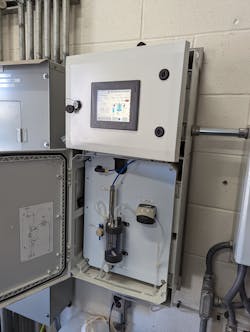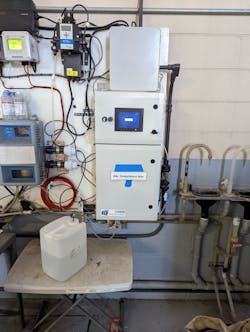ECD alkalinity analyzer helps optimize corrosion control
As the water utility serving a consolidated city and county government, Denver Water offers high-quality water and promotes its efficient use to residents. Its primary water sources include: the South Platte River, Blue River, Williams Fork River and Fraser River watersheds, along with South Boulder Creek, Ralston Creek and the Bear Creek watersheds.
At an altitude of 5,280 feet, the mile-high City of Denver, along with the County of Denver’s surrounding communities, is a thriving metropolitan area that 1.5 million residents call home. They all depend on Denver Water to provide clean, safe drinking water, which includes a treatment and delivery system free of pipe corrosion issues.
The water challenge
Since the Flint, Michigan drinking water crisis, Denver, like many other municipal, county and state water agencies across the nation, has been concerned about the potential effects of lead piping system corrosion and moved quickly to address it. The U.S. EPA in response directed water treatment agencies to begin applying several different methods to prevent the corrosion of aging piping infrastructure, which might include lead.
One of the most popular methods of inhibiting corrosion is the use of orthophosphate treatments1. Their use can prevent the leaching of lead and copper from water pipe systems as they age. They have been studied by EPA and, while effective, can be complex to implement correctly based on multiple variables such as achieving the correct orthophosphate concentration and the corrosion scale composition levels already existing in the piping system.
Another EPA recommended method of preventing/controlling corrosion in piping is adjusting the pH/alkalinity/dissolved inorganic carbon (DIC) concentration ratios2. Water engineers and technicians typically monitor and understand well their required pH and alkalinity levels needed for water disinfection and quality purposes. DIC, however, is the less familiar inorganic carbon level within water, and it is measured or inferred indirectly via an estimate based on pH and alkalinity levels.
Understanding the proper relationship between pH, alkalinity and DIC is important to prevent corrosion in piping, which can result in the release of lead and copper contaminants into the water system. After reviewing EPA’s corrosion treatment guidance and the unique characteristics of its own lead piping water system, the agency’s Startup, Commissioning and Optimization (SCO) group chose the pH/alkalinity/DIC adjustment method to control corrosion, which required the evaluation and installation of new alkalinity analyzers to support its treatment system. The SCO group’s major reason for choosing this option was that the orthophosphate rust inhibitor method would have also affected Denver’s wastewater plants. The wastewater treatment plants would then have had to remove orthophosphate before releasing final effluent from its plant.
Alkalinity measurement
Alkalinity is a measure of the capacity of water to neutralize acids. Alkaline compounds such as bicarbonates, carbonates and hydroxides remove hydrogen (H2) ions and lower the acidity of the water to prevent pipe corrosion. This is done by combining the H2 ions to make new compounds. Alkalinity is influenced by rocks and soils, salts, certain plant activities, and possible industrial wastewater discharges.
Total alkalinity is determined by measuring the amount of acid needed to bring the sample to a specified pH endpoint. At this pH, all the alkaline compounds in the sample are “used up.” The result is reported as ppm or milligrams per liter of calcium carbonate (ppm or mg/L CaCO3). Titration analyzers calculate alkalinity by dispensing “shots” of a known concentration of titrant into a reaction cell. A carefully prepared sulfuric acid solution is typically used as the titrant.
The pH level is monitored throughout the alkalinity analysis cycle by using an included pH sensor, and this is done until the sample reaches the pH endpoint. The analyzer then uses the titrant concentration and the amount dispensed to calculate the resulting measurement of alkalinity present in the sample.
Pilot testing of two alkalinity analyzers
As part of implementing its pH/alkalinity/DIC corrosion control system, the Water Quality (WQ) Group at Denver Water decided to conduct a pilot program to test two different alkalinity analyzers. The CA900 Alkalinity Analyzer from Electro-Chemical Devices (ECD) and one other alkalinity analyzer from another popular, well-respected manufacturer were both tested. They were installed at a pump station and were connected to the Denver Water SCADA system as part of the evaluation.
Both ECD and the other manufacturer in the pilot program offer similar titration method alkalinity analyzers. Titration analyzers are popular with users because of their ease of use, low maintenance compared to other technologies and therefore lower installed and life cycle costs.
There were a couple of design differences between the two titration analyzer unit technologies evaluated by Denver Water. The first difference related to the design of the units, which affected the amount of titrant reagent required, the life of the pH sensor electrodes and therefore the maintenance and consumable reagent costs. These differences were noted by Denver Water in the respective manufacturer specifications of the two analyzers under evaluation.
In addition, the WQ Group at Denver Water noted that the two analyzers utilize different types of reagent pumps. The ECD analyzer utilizes a micro-pump while the other competitive unit uses a syringe pump. During the testing of the two analyzers, the unit from the second manufacturer failed due to syringe pump issues, which were not corrected successfully by the manufacturer’s field team.
The ECD CA900 Titration Analyzer typically performs a single alkalinity measurement per analysis cycle. Its program sequence consists of a cleaning cycle, sample acquisition, monitoring of pH, the addition of the titrant fluid, mixing the fluid, calculation of results and data storage. The desired frequency of analysis between cycles can be easily modified to the requirements of the user’s process.
Denver Water required an alkalinity measurement range of 0 to 200 pm. Most users select from one of four Model CA900 standard calibration ranges: 0 to 50 ppm, 50 to 200 ppm, 200-1000 ppm, and 0 to>1000 ppm. The Denver Water team, when ordering for the evaluation trial period, requested a custom 0-200 ppm alkalinity calibration range; and the analyzer came programmed by ECD to the 0-200 ppm range. The analyzer also comes with four 4-20 analog outputs, an Ethernet digital output and four user-configurable alarm relays.
Accessing information or customizing analysis routines are both accomplished with the CA900 Titration Analyzer’s menu and touchscreen interface. The analyzer also can be web-enabled for remote monitoring and interfacing with personal handheld devices such as controllers, mobile phones, tablets, laptops and computers.
The alkalinity analyzer test results
ECD’s application team was in regular contact with the team at Denver Water to provide support and the chemical reagent for the trial. The trial of the ECD CA900 and the other competitor titration analyzer was designed to last for about one year. No matter the method of corrosion prevention chosen by any water agency, accurately monitoring various water parameters is critical to the success of the system’s performance, maintenance and cost.
At the end of the trial, the SCO Group told ECD, “The CA900 Analyzer was approved by the Denver Water evaluation team because it met our system’s requirements with accurate alkalinity measurement, a user-friendly interface, ease of maintenance, lower cost of ownership and customer support.”
A total of seven ECD alkalinity analyzers were purchased for the corrosion monitoring control project and installed across Denver Water’s distribution system.
Installation and conclusion
The WQ Group at Denver Water explained that, when the new CA900 Analyzers were installed, there were two technical issues.
The first issue related to the need to install a software update — which was easily completed. The second issue related to the fact that the software of the CA900 analyzer stored some Denver water data setting on the volatile memory side because the product was relatively new to the market.
Denver Water was concerned about the potential loss of system historic alkalinity level and event data. The WQ Group at Denver Water decided to install uninterruptible power supplies (UPS) on each unit. After this was accomplished, the team at Denver Water was still concerned about the reliability and battery life of the UPS units, which also required an additional maintenance routine, technician time and costs.
The WQ Group then approached the ECD field service team with Denver Water’s concerns about this issue. In response, ECD’s engineer created an updated firmware solution that relocated the setting from the violate side to non-volatile memory, which protected the alkalinity measurement setting and eliminated the need for the UPS units. The WQ Group said this software update resolved all potential data loss concerns.
With these two issues resolved, the WQ Group said the analyzers continue to perform well and provide accurate alkalinity measurements. ECD today continues to support Denver Water as necessary with routine software upgrades, pH electrodes, reagents and other components.
References
White Paper, “The Role Of Alkalinity In Aerobic Wastewater Treatment Plants: Magnesium Hydroxide vs. Caustic Soda,” Martin Marrietta Magnesium Specialties, Water Online: https://www.wateronline.com/doc/the-role-of-alkalinity-in-aerobic-wastewater-0002
U.S. EPA, “Optimal Corrosion Control Treatment Evaluation Technical Recommendations for Primacy Agencies and Public Water Systems Section: 2.3.1.”
About the Author
Anil Isaac
Anil Isaac is a Senior Applications Engineer at Electro Chemical Devices Inc. (ECD), offering 15 plus years of process industry field experience with liquid analyzers, flow meters, and pressure and temperature sensors. He also has product development experience and holds a B.S. in electrical and computer engineering from California State Polytechnic University, Pomona, CA.



